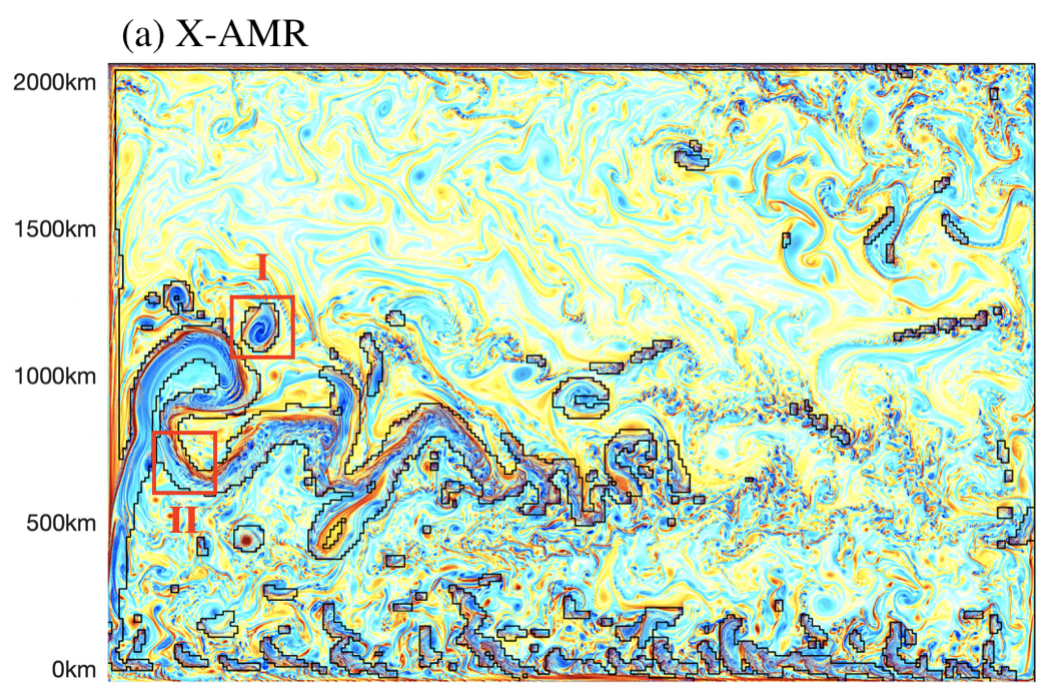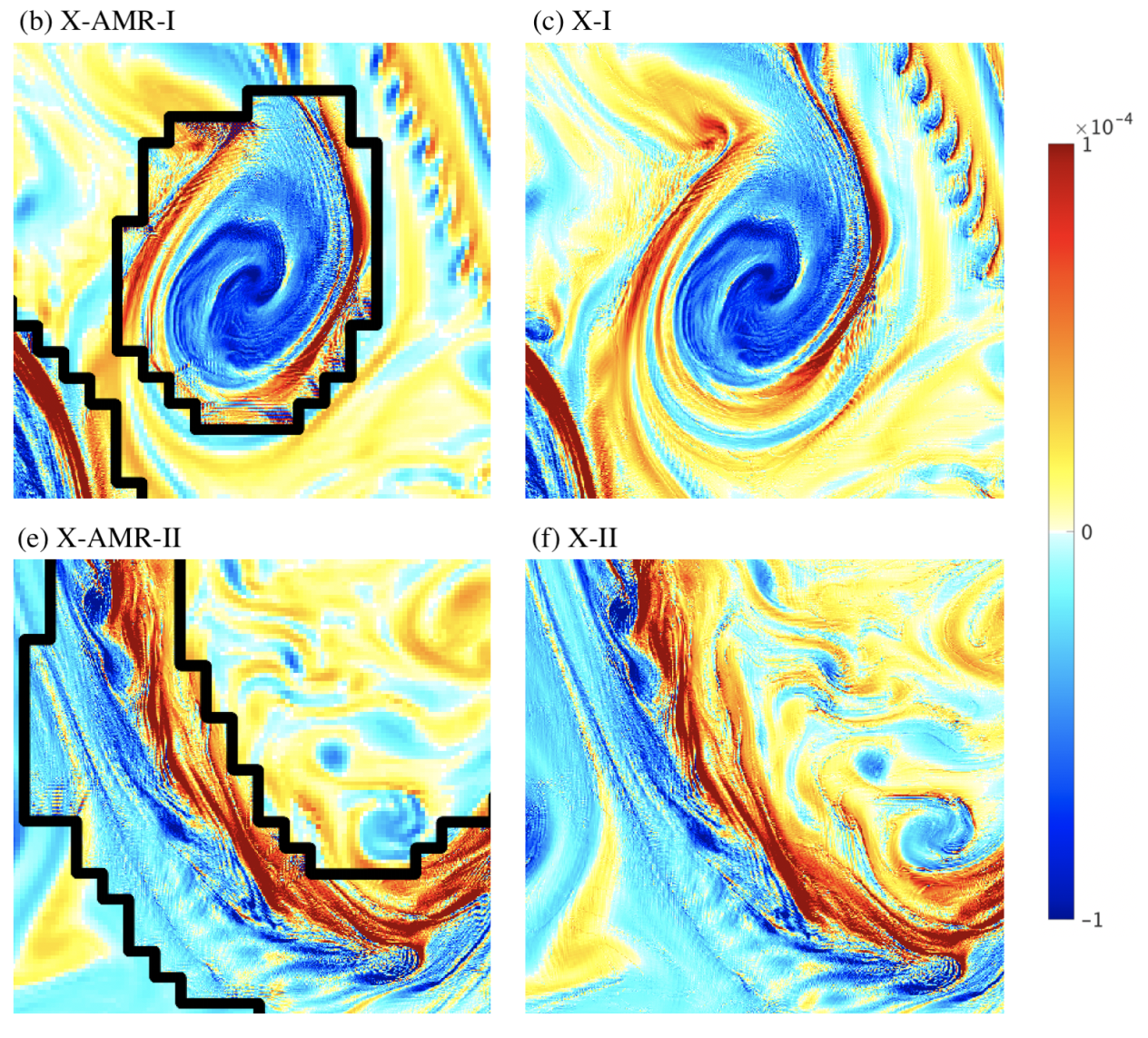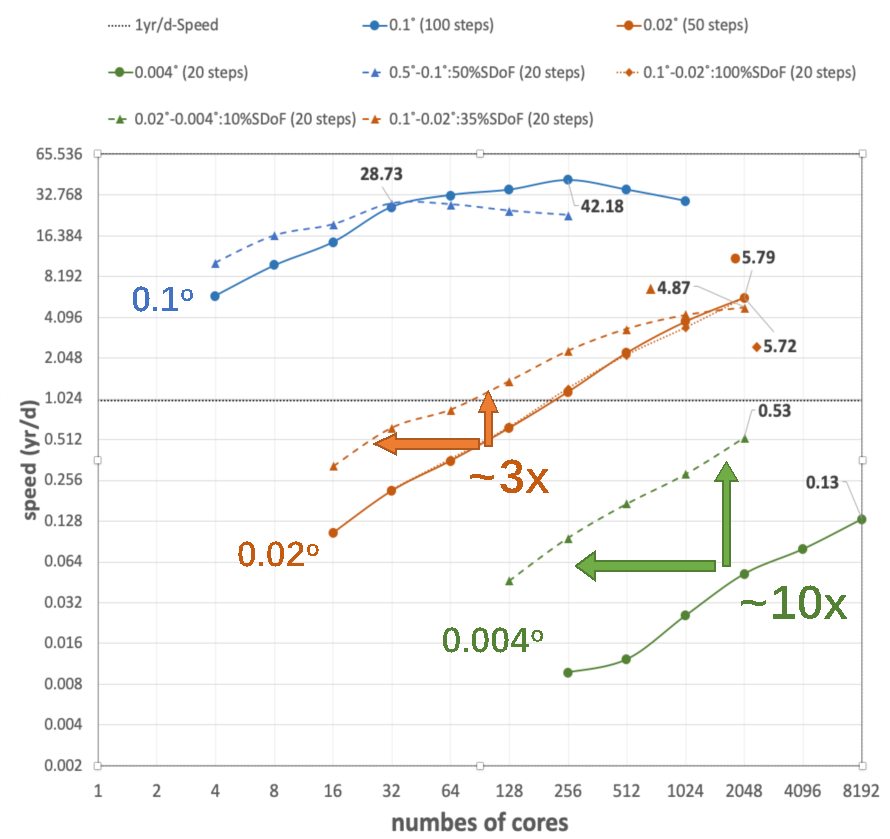High-resolution ocean-sea ice models are core tools for climate change research and marine environmental security. With improvement of the resolution, the models can effectively analyze the refined process of ocean power and heat, and lower the uncertainty incurred by parameterization. The most advanced global ocean model in the world features a resolution of 1 ~ 2 kilometers, able to effectively analyze some ocean sub-mesoscale processes. However, due to the multi-scale characteristics of ocean processes, the numerical model faces serious challenges such as analyzing more detailed processes, limited effective resolution, and the development of sub-grid closure schemes. In addition, the high-resolution model usually requires extremely high computation and simulation time, which seriously limits its applicability in climate research and business.
In light of the international frontier of ocean circulation model development, the research group of Associate Professor Xu Shiming from the Department of Earth System Science (DESS), Tsinghua University has developed an international ocean circulation model OMARE (Ocean Modeling with Adaptive REsolution) with adaptive mesh refinement (AMR) and flexible modeling functions. The OMARE model is built on the basis of the dynamic framework of NEMO ocean model with baroclinic explicit split format and JASMIN high-performance scientific software middleware, achieving multiple design goals such as improving the function of the model, developing flexible ocean modeling and improving computational efficiency. The OMARE adopts the mixed programming framework of C++ and FORTRAN, and develops pattern development specifications such as binary consistency and step-by-step debugging. The total amount of newly developed code amounts to more than 130,000 lines.
The OMARE model mainly addresses four resolutions (spatial refinement ratio being 1:5): 0.5º(50 km), 0.1º (10 km), 0.02 º (2 km) and 0.004 º (400 m), which respectively address climate simulation, ocean mesoscale analysis, partial mesoscale analysis and most mesoscale analysis.

Fig. 1. Surface Rossby number after winter 0.02º full-field refinement (a) and adaptive refinement (b and c) and the result of 0.1º in the same period.
As shown in Fig. 1, the typical winter surface Rossby number(Ro=zeta/f) with dynamic refinement from 0.1º to 0.02º (the refinement criterion is based on sea surface current and relative vorticity) shows tha 0.02º refinement can accurately grasp the dynamic processes such as western boundary current and main mesoscale systems, and can simulate the sub-mesoscale processes (|Ro|>1) of the full-field 0.02º test in these areas. Based on the dynamic refinement (flow velocity) from 0.02 degrees to 0.004º, we can further analyze the fine structures such as vortex wires and fronts in the sub-mesoscale (Fig. 2). The dynamic refinement experiment has a good and reasonable calculation speed (Fig. 3). Through local refinement, while ensuring the fine simulation of key areas and key processes, the overall calculation scale is reduced in equal proportion, which effectively improves the simulation speed of high-resolution mode. In the future, OMARE model will further focus on the improvement of numerical scheme and refinement scheme, the large-scale impact of small-scale ocean processes, ocean energy cycle and cascade, and polar ocean sea ice simulation.


Fig. 2. Sea surface relative vorticity (a), mesoscale vorticity (b, area I) and details of the refined area of the western boundary current principal axis (c, area II) of 0.004º adaptive refinement test based on current velocity

Fig. 3. Computational performance and scalability analysis of local refinement (dotted line) and full-field test (solid line) based on Intel high-performance cluster.
The related results have been published in Geoscientific Model Development as an article titled “Ocean Modeling with Adaptive REsolution (OMARE, version 1.0) Refactoring NEMO model (version 4.0.1) with the parallel computing framework of JASMIN. Part 1: adaptive grid refinement in an idealized double-gyre case”. doctoral students of the DESS, Tsinghua University, Zhang Yan (the first author), Wang Xuantong (the second author) and Ning Chenhui (the fourth author) are the main members for the development of the OMARE model. Associate Professor Xu Shiming and Researcher An Hengbin of the Beijing Institute of Applied Physics and Computational Mathematics are the co-authors of the article, and Wang Bin, a distinguished visiting professor of the DESS, Tsinghua University, has directed the relevant work. Co-authors also include researchers from Beihang University and the Institute of Atmospheric Physics of the Chinese Academy of Sciences. This work is supported by the key research and development project "Global Change and Response" of the Ministry of Science and Technology (2017YFA0603900) and the National Natural Science Foundation (42030602).
Article information:
Yan Zhang, Xuantong Wang, Yuhao Sun, Chenhui Ning, Shiming Xu*, Hengbin An*, Dehong Tang, Hong Guo, Hao Yang, Ye Pu, Bo Jiang, and Bin Wang. 2022. Ocean Modeling with Adaptive REsolution (OMARE, version 1.0) - Refactoring NEMO model (version 4.0.1) with the parallel computing framework of JASMIN. Part 1: adaptive grid refinement in an idealized double-gyre case, Geoscientific Model Development, 16, 679–704, doi:10.5194/gmd-16-679-2023.
Written by Xu Shiming
Edited by Wang Jiayin
Reviewed by Zhang Qiang